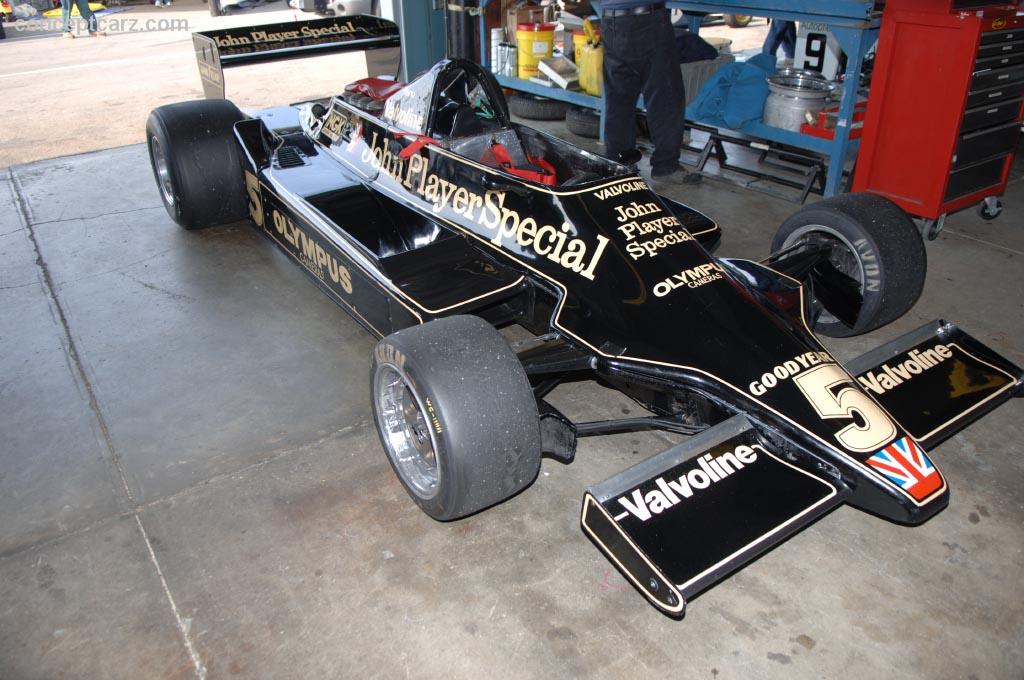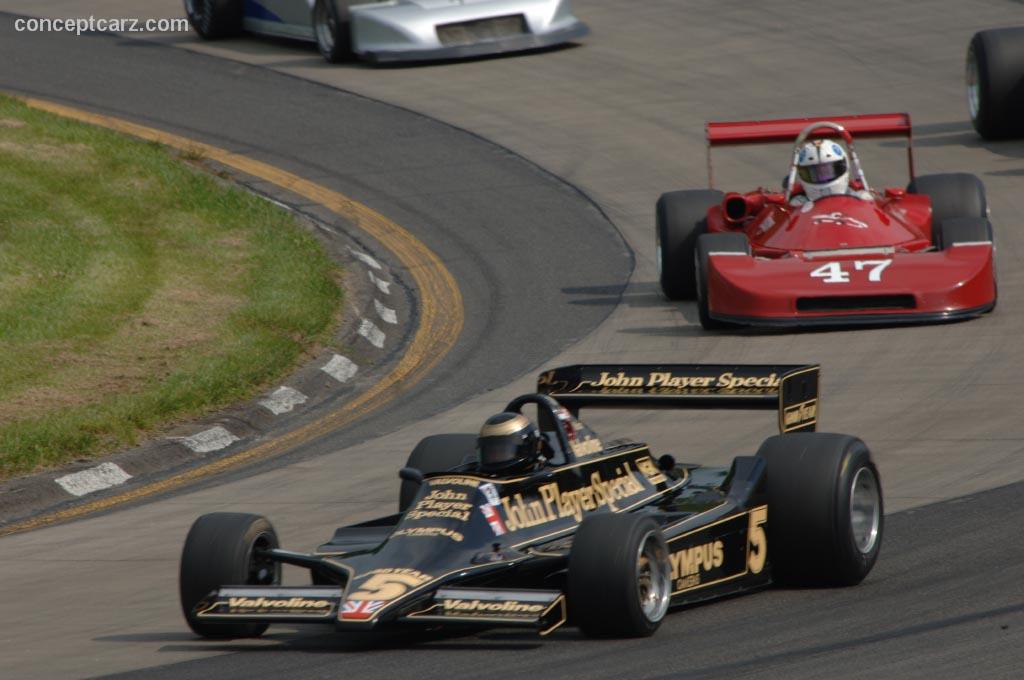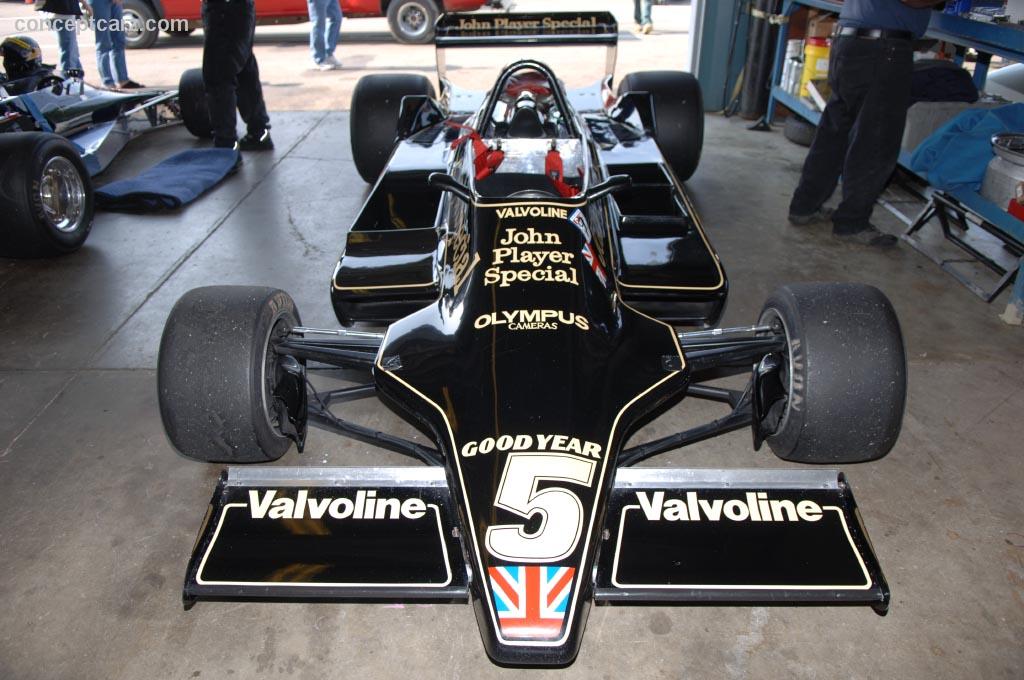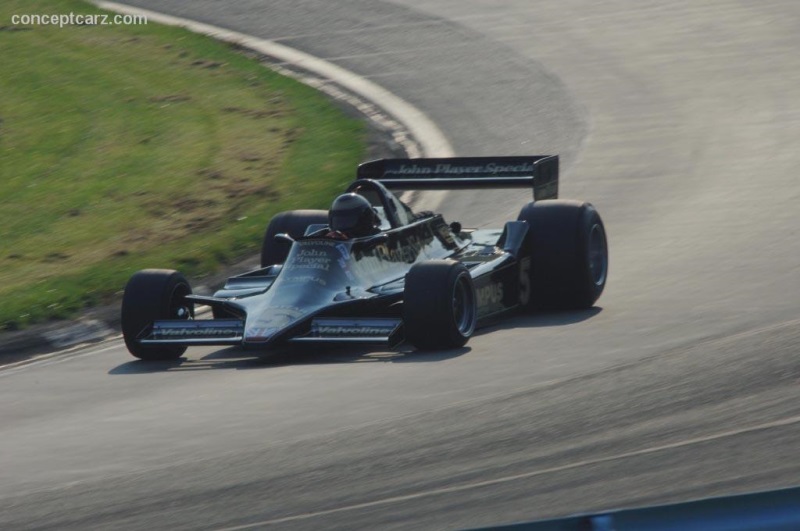Image credit: © conceptcarz.com (Reproduction Or reuse prohibited).
The Lotus 79 John Player Mark IV Formula 1 car was designed to improve aerodynamic and ground effects and improve upon the design of the Type 78. It was intended for the 1978 season but was not ready by the season's opener. Ronnie Peterson and Mario Andretti drove the Lotus 78 car instead. The 79 continued to undergo testing and development at the Paul Ricard circuit. When the car was ready, it was driven by Andretti with Peterson still driving the Type 78. Soon, both were driving the Type 79 and finished the season in the first two places in the Drivers' Championship. Though this was a brilliant victory for the Lotus team, they were marked by sadness. At the 1978 Italian Grand Prix at Monza, Ronnie had been driving a Lotus 79 that he had damaged in practice. The team had a spare car but it was intended for Andretti and was unable to fit the taller Peterson. At the start of the race, several cars in the middle of the pack jumped the start. This resulted in a large congregation of cars at the recently added chicane and just before the 'curva grande' corner. Peterson's car collided with James Hunt, among others, and sent the Lotus 79 with Peterson into the barriers. The vehicle caught on fire and he was unable to exit his car. He was freed from the wreck by Depailler, Regazzoni, and Hunt before he sustained major burns. X-rays at the hospital showed that he had 7 fractures in one leg and 3 in the other. Surgeons operated later that night; over the evening hours, bone marrow got into his bloodstream through the fractures. When the morning arrived, he was in full renal failure and declared dead a few hours later.
Ronnie Peterson had raced in 123 Grand Prix races and was the winner of ten of those races.
Part of the ways to improve the vehicle's aerodynamics was to remove the outboard fuel tanks and the outboard rear suspension. F1 regulations stated that a capacity limit of 80 liters was allowed for each fuel tank. Chapman was able to get permission to merge the two fuel tanks together and mount the single unit behind the driver and in front of the engine. To make additional room, the driver was moved forward. The suspension was now inboard to remove any hindrance of obstructing air as it flowed through the car and to its exit points. Double-caliper disc brakes were inboard at the rear and outboard at the rear.
To continue the notion of improving airflow, the exhausts had an up-and-over design. The engine, fully enclosed, was the Cosworth DFV unit matted to a new Lotus transmission. The new gearbox was an improved sequential unit that was very compact and strong. The driver was no longer required to operate a clutch to change gears; rather, just let up on the throttle when making upward changes. The new gearbox was used for only a short time before the team reverted back to Hewland units.
The Lotus Type 79 was tested thoroughly at the Paul Richard circuit near the close of 1977. It was fast but the massive amounts of g-forces, about 30% more downforce created by the Type 78, introduced potential problems for the chassis. To solve these issues, the chassis was strengthened in specific points. To accommodate Peterson's larger frame and necessary knee room, the dash hoop and front panel were raised. Changes were made where necessary, including the suspension.
The car was introduced at the International Trophy at Silverstone where it was hailed by fans as the 'Black Beauty'. It was finished in black and gold livery and had sponsorship by John Player Special cigarettes. The Silverstone race had been dry during practice, but the race was met with torrential rain. As a result, many drivers crashed. The Lotus machines, though running very strong throughout the race, were forced to retire. Andretti later drove the 79 at the Belgian Grand Prix at Zolder and easily won the race. The Lotus 79 machines were so superior to the other competition, that most of its losses occurred when it failed to finish.
The 79 was replaced by the Lotus 80 in 1979. Martini Racing replaced John Player Special as a sponsor and the cars were adorned in British racing green. The Lotus 80 failed to live up to expectations and the team reverted back to the 79 with Andretti and Carlos Reutemann as drivers. By now, the competition had caught up in terms of design and the use of aerodynamics. The Type 79 was unable to compete as it had in seasons past. Lotus finished the season fourth in the constructors' championship and the car was officially retired.
The Lotus 79 had a very impressive racing history, accounting for the last drivers' and constructors' world championship for Lotus. The car had 7 wins and 10 pole positions and amassed 121 points.
The example shown is chassis number 19 and driven by Divina Galica.By Daniel Vaughan | Aug 2010
Ronnie Peterson had raced in 123 Grand Prix races and was the winner of ten of those races.
Part of the ways to improve the vehicle's aerodynamics was to remove the outboard fuel tanks and the outboard rear suspension. F1 regulations stated that a capacity limit of 80 liters was allowed for each fuel tank. Chapman was able to get permission to merge the two fuel tanks together and mount the single unit behind the driver and in front of the engine. To make additional room, the driver was moved forward. The suspension was now inboard to remove any hindrance of obstructing air as it flowed through the car and to its exit points. Double-caliper disc brakes were inboard at the rear and outboard at the rear.
To continue the notion of improving airflow, the exhausts had an up-and-over design. The engine, fully enclosed, was the Cosworth DFV unit matted to a new Lotus transmission. The new gearbox was an improved sequential unit that was very compact and strong. The driver was no longer required to operate a clutch to change gears; rather, just let up on the throttle when making upward changes. The new gearbox was used for only a short time before the team reverted back to Hewland units.
The Lotus Type 79 was tested thoroughly at the Paul Richard circuit near the close of 1977. It was fast but the massive amounts of g-forces, about 30% more downforce created by the Type 78, introduced potential problems for the chassis. To solve these issues, the chassis was strengthened in specific points. To accommodate Peterson's larger frame and necessary knee room, the dash hoop and front panel were raised. Changes were made where necessary, including the suspension.
The car was introduced at the International Trophy at Silverstone where it was hailed by fans as the 'Black Beauty'. It was finished in black and gold livery and had sponsorship by John Player Special cigarettes. The Silverstone race had been dry during practice, but the race was met with torrential rain. As a result, many drivers crashed. The Lotus machines, though running very strong throughout the race, were forced to retire. Andretti later drove the 79 at the Belgian Grand Prix at Zolder and easily won the race. The Lotus 79 machines were so superior to the other competition, that most of its losses occurred when it failed to finish.
The 79 was replaced by the Lotus 80 in 1979. Martini Racing replaced John Player Special as a sponsor and the cars were adorned in British racing green. The Lotus 80 failed to live up to expectations and the team reverted back to the 79 with Andretti and Carlos Reutemann as drivers. By now, the competition had caught up in terms of design and the use of aerodynamics. The Type 79 was unable to compete as it had in seasons past. Lotus finished the season fourth in the constructors' championship and the car was officially retired.
The Lotus 79 had a very impressive racing history, accounting for the last drivers' and constructors' world championship for Lotus. The car had 7 wins and 10 pole positions and amassed 121 points.
The example shown is chassis number 19 and driven by Divina Galica.By Daniel Vaughan | Aug 2010
No auction information available for this vehicle at this time.
Recent Sales of the Lotus 79 John Player Special Mark IV
(Data based on Model Year 1978 sales)
Lotus 79 John Player Special Mark IVs That Failed To Sell At Auction
1978 Lotus 79 John Player Special Mark IV's that have appeared at auction but did not sell.
| Vehicle | Chassis | Event | High Bid | Est. Low | Est. High |
|---|
Vehicles With Comparable Market Values
Similar sales to the range.
1978 Lotus 79 John Player Special Mark IV
• Additional valuation insight and sales data• History
• Specifications
• Image gallery













